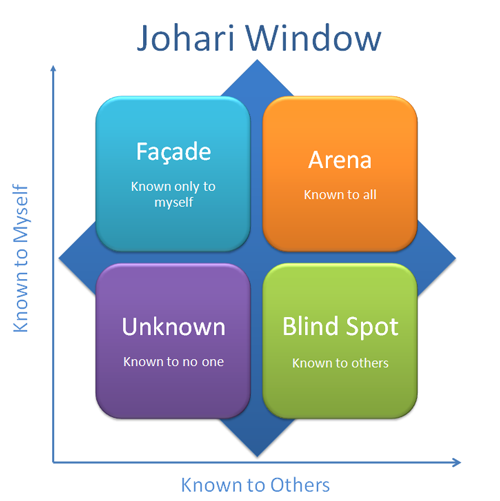Johari Window
Objective: To show how communication occurs at two levels.
Time: about 30 Minutes
Instructions
1. Read and discuss The Johari Window that is listed below.
2. Divide the class into small groups and have them discuss the questions.
3. Have each group list their findings on a flip chart.
4. When they are finished, rejoin them into one large group and have each group discuss their findings.
The Johari Window
In 1955, Joseph Luft and Harrington Ingram created a quadrant to reveal what we know or don't know about something and what others know or don't know about something. They called it the “Johari Window of Opportunity” (JOseph and HARrIngton).
They theorized that the communications process occurs at two levels:
- The overt level — what was actually said
- The convert or hidden level — what is actually meant
When the two levels of the communication process are viewed from the perspectives of the communicator and the listener, it provides four panes into the window on how we give and receive information about ourselves and others:

- Arena — Known to self and others: This is also known as the Public Area. New team members normally have smaller Arenas than established team members. The goal of the team and leaders is to expand the Arenas, as the more we know about the people who work with us, the more productive the team becomes.
- To expand the Arena vertically into the Blind Spot, team members should offer feedback, however, they need to be aware of and responsive to the feelings of others. The person can also learn about his or her Blind Spot through the use of feedback solicitation — actively seek and listen to the feedback of team members.
- To expand the Arena diagonally into the Unknown, use Self-Discovery; thus, rather than learning about yourself via others, you use various activities to learn about your priorities and spiritually.
- http://www.businessballs.com/johariwindowmodel.htm
- file:///C:/Users/Don/Documents/Performance%20Site/leader/johari.html
- Facade — Known to self, but unknown to others: This hidden self is any information that a person knows about him or herself, but is not not revealed to others. Sometimes there is a good reason for holding something back, such as to prevent gossip or the information is unimportant. At other times it might be bad for the communication process, such as holding something back because it gives us a false sense of job security.
- To expand the Facade into the Arena, the person should discuss his or her feelings and offer information to other team members. In addition, team members should ask the person to talk about him or herself.
- Blind Spot — Unknown to self, but known to others: Sometimes we communicate something we are unaware of. For example, I might say, "I'm not angry," while slamming my fist on the table.
- Unknown — Unknown to neither self not others
Questions
- What pane can lead to confusion? Why?
- What pane is not really troublesome, however it can lead to the most opportunities for improvement? Why?
- What are some other reasons that people might hold back (Facade)?
Instructor Answer Guide
Question 1: Facade, as it may convey double meanings to others (confusion). i.e., you tell your team to make decisions while you are gone, but you usually turn the decisions around when you get back.
Question 2: The Unknown, as these can be thought of as windows of opportunity — better communication processes, brainstorming sessions, learning to trust others, etc. This is where we turn the unknown into the known.
Question 3: Lack of trust, we may have feelings we do not feel comfortable discussing with others until we get to know them real well, we do not want to hurt someone, etc.
Next Steps
This learning activity is for the chapter on Communication and Leadership
Return to the Leadership Training and Development Outline
